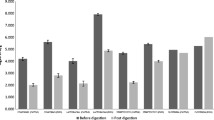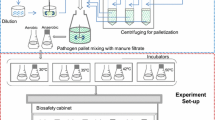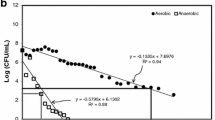Abstract
The survival of certain pathogenic bacteria was studied in anaerobic batch digesters at room temperature (18–25 °C) as well as at 35 °C under laboratory conditions. The survival of Escherichia coli and Salmonella typhi at room temperature was upto 20 days whereas at 35 °C it was only upto 10 days. Shigella dysenteriae was found to be the most sensitive organism which could survive upto 10 days at room temperature and upto 5 days at 35 °C. The longest survival was observed in case of Streptococcus faecalis which could survive upto 35 days at room temperature and 15 days at 35 °C. The survival time of Salmonella typhi increased when the solid contents of the digester were elevated from 9% to 15%.
Similar content being viewed by others
References
APHA 1985 Standard methods for the examination of water and waste water 16th ed. Washington, DC: APHA AWWA, WPCF. ISBN 0–87553131–8.
Bendixen, H.J. 1994 Safeguards against pathogens in Danish biogas plants. Water Science Technology 30, 171–180.
Bremner, J.M. 1965 Inorganic forms of nitrogen. In Methods of soil analysis: chemical and microbiological properties. Vol. 2, ed. Black, C.A. pp. 1179–1237. Wisconsin, WI: American Society of Agronomy.
Chawla, O.P. 1986 Advances in Biogas Technology. New Delhi, India: Publication and Information Division, Indian Council of Agricultural Research.
Gadre, R.V., Ranade, D.R. & Godbole, S.H. 1986 A note on survival of Salmonellas during anaerobic digestion of cattle dung. Journal of Applied Bacteriology 60, 93–96.
Jones, P.W. 1976 The effect of temperature, solid content and pH on the survival of Salmonellas in cattle slurry. British Veterinary Journal 132, 284–293.
Juris, P., Toth, F., Laukova, A., Plachy, P., Bubinsky, P. & Sokol, J. 1996 Survival of model bacterial strains and helminth eggs in the course of mesophilic anaerobic digestion of pig slurry. Veterinary Medicine 41, 149–153.
Kalia, A.K. & Kanwar, S.S. 1989 Temperature pro®les of biogas plants operating under hilly conditions. Biological Wastes 30, 217–224.
Kalia, A.K. & Kanwar, S.S. 1990 Anaerobic fermentation of Ageratum for biogas production. Biological Wastes 32, 155–158.
Kalia, A.K. & Kanwar, S.S. 1991 Biogas technology in Himachal Pradesh: an evaluation study. SESI Journal 1, 1–11.
Kanwar, S.S. & Kalia, A.K. 1993 Anaerobic fermentation of sheep droppings for biogas production. World Journal of Microbiology and Biotechnology 9, 174–175.
Kanwar, S.S., Gupta, R.K., Guleri, R.L. & Singh, S.P. 1994 Performance and evaluation of 1 m3 modified, fixed dome Deenbandhu biogas plant under hilly conditions. Bioresource Technology 50, 239–241.
Munch, B., Larson, H.E. & Aalbaeck, B. 1987 Experimental studies on the survival of pathogenic and indicator bacteria in aerated and nonaerated cattle and pig slurry. Biological Wastes 22, 49–65.
Olsen, J.E. & Larson, H.E. 1987 Bacterial decimation times in anaerobic digesters of animal slurries. Biological Wastes 21, 153–166.
Plym-Forshell, L. 1995 Survival of Salmonellas and Ascaris suum eggs in a thermophilic biogas plant. Acta Veterinaria Scandinavica 36, 79–85.
Ripley, L.E., Boyle, W.C. & Converse, J.C. 1986 Improved alkalimetric monitoring for anaerobic digestion of high strength wastes. Journal of Water Pollution Control Federation 54, 406–411.
Satyanarayan, S., Badrinath, S.D. & Gadkari, S.K. 1987 Anaerobic treatment of human wastes. Indian Journal of Environmental Protection 7, 5–10.
Sharma, S.K., Saini, J.S., Mishra, I.M. & Sharma, M.P. 1987 Mirabilis leaves - a potential source of methane. Biomass 13, 13–24.
Singh L., Maurya, M.S., Ram, M.S., Alam, S.I. & Sai Ram, M. 1993 Biogas production technology from night soil: E.ects of loading and temperature. Bioresource Technology 45, 59–61.
Singh' Shiv, P., Vatsa, D.K. & Verma, H.N. 1997 Problems with biogas plants in Himachal Pradesh. Bioresource Technology 59, 69–71.
Sorlini, C., Allievi, L., Ranalli, G. & Ferrari, A. 1987 A note on the removal of fecal bacteria in cattle slurry after di.erent farm and laboratory treatments. Biological Wastes 22, 39–47.
Wray, C. 1975 Survival and spread of pathogenic bacteria of veterinary importance within the environment. Veterinary Bulletin 45, 543–550.
Author information
Authors and Affiliations
Rights and permissions
About this article
Cite this article
Kumar, R., Gupta, M. & Kanwar, S. Fate of bacterial pathogens in cattle dung slurry subjected to anaerobic digestion. World Journal of Microbiology and Biotechnology 15, 335–338 (1999). https://doi.org/10.1023/A:1008906831493
Issue Date:
DOI: https://doi.org/10.1023/A:1008906831493




